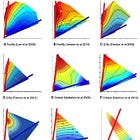Are Calories 'Real'?
Why the calorie is a reductionistic fiction & how it sufficates our conception of energy.
It’s safe to say that if you asked anyone on the street how to lose weight, the first thing they might say is to reduce your caloric intake. This answer is almost always coupled to another that is functionally identical, which is to exercise more in order to ‘burn’ more calories. This seems logical enough; if the amount of calories in surpasses the number of calories used, the surplus must be stored. But what even is a calorie? One might be excused for neglecting such a query given the fact that we have collectively accepted it as a foundational currency of the body. Food labels are branded with caloric contents, treadmills brandish stats of calories burned as motivation1 and marketers make foods with low caloric content by creating synthetic sweeteners.
There unfortunately remains two fundamental questions in the caloric paradigm that need to be more widely acknowledged: What is a calorie? & Does the human body regulate weight by a linear counting method?

What is a calorie?
To understand and critique the caloric paradigm, we must first try and understand the foundations upon which it was built. A calorie was first theorised in the first part of the 20th century by French chemist Nicholas Clément. It was used in the early formulations of thermodynamics and the relationship between heat and energy; something vital for the use of steam engines at the time. A calorie is defined as the energy required to raise the temperature of 1kg 1°C. It wasn’t until much later when physiologists like Max Rubner and later Wilbur Atwater2 applied the concept to human metabolism.
The astute reader will no doubt be thinking, ‘How does this definition of a calorie apply to human metabolism?’ To put it bluntly, it doesn’t. Even Rubner himself was dissatisfied with the notion that all calories have equal metabolic consequences; a saying that was inappropriately derived from his work. Unfortunately, the notion that ‘a calorie is a calorie' is still somewhat in vogue since morphing into the idea of CICO (calories in, calories out).3
The way the caloric content of food is measured is essentially by placing the food atop some water, burning it and measuring how much the water’s temperature increased as a result of the combustion of the food.
“A sample of the food is placed in an insulated, oxygen-filled chamber that is surrounded by water. This chamber is called a bomb calorimeter. The sample is burned completely. The heat from the burning increases the temperature of the water, which is measured and which indicates the number of calories in the food.”
This method makes sense from the standpoint of early thermodynamicists attempting to quantify energy and heat generation due to work done. However, this hardly seems appropriate for infinitely complex systems like the human body. I hazard a guess that if the average person knew that this is what a calorie really is that they would no longer take too seriously the concept that their weight is determined by ‘caloric balance'. Yet as a culture, we have, without critique, accepted the antiquated notion that the human body is merely a caloric abacus, regulating adiposity in the most linear of ways. Even the concept of 'burning' calories is a callback to the thermodynamics of steam engines.
Calories as a unit of measurement are 'real' in the sense that we define it as such. But the unit of measurement cannot be applied beyond the reductionist and linear framework from which it was born. For all intents and purposes, nutrition should only see the calorie as a somewhat useful fiction; one that can convey a broad conceptualisation of the approximate amount of food to nourish oneself. It should be stressed that this is the best case scenario for its clinical use. It may even be that nutrition as a whole should divorce the term all together as it serves the best interests of almost no one while dangerously obscuring the true nature of how the body interacts with all aspects of the environment.4 Calories do not ‘exist’ outside of our own conception of them as a unit of energy.
“[T]he idea that nature is governed by simple, knowable laws seemed to be a perfect example of anthropocentric foolishness.”
-Ilya Prigogine on Joseph Needham's, 'Science and Society'
Does the human body regulate weight by a linear counting method?
Adiposity, weight distribution and bioenergetics are regulated by complex interactions between the organism and its environment. The obesity epidemic we are living through today is not a result of excessive intake of food alone. Of course, the landscape of food choices today has shifted remarkably in the last century making it seem like 'calories' are the enemy. This is because the increasing processing of foodstuffs has enabled us to concentrate refined macronutrients - specifically fat and carbohydrates.5

Even if calories were 'real', the human body does not operate within constraints of linear dynamics. Weight regulation depends on a complex mixture of cues from light timing and spectral content, sleep quality, nutritional status, electromagnetic environment, psychological state and much more. The obesity epidemic cannot be reduced to the adage 'eat less and exercise more'.
“The guiding motto in the life of every natural philosopher should be, seek simplicity and distrust it.”
-Alfred North Whitehead
Another key issue with the calorie paradigm is it actively fails to address nutrient density or food quality. This system of calorie counting and treating food intake like a bank account implicitly states what Rubner rallied against in his initial investigations of the calorie in physiology; that each calorie should be treated equally. No one would suggest that the metabolic impacts of isocaloric intake of candy versus vegetables are identical, yet this is the thinking that is implicitly embedded into this caloric paradigm.

The body does not regulate the deposition or oxidation of adipose tissue based on a unit of energy formulated a couple of centuries ago. Many people understand this experientially. I personally realised this long ago as I can consistently 'overconsume calories' and never gain any additional fat mass. I also know people who can eat so little, yet because their environments are so poor they are never capable of losing weight. This is often attributed to having individuals having characteristically slow or fast metabolisms, a concept that does appear to have some truth attached to it.
Another curiosity that arises when examining the reality of calories and even more broadly, where we attain energy, is migratory birds. These birds travel extraordinary distances in incredibly short amounts of time. They do so without stopping to provision resources, a feat that has left many biologists baffled as to how they can traverse such distances without eating.

Summary
Calories are used as a way of understanding weight management and energy balance. Calories are colloquial in the sense that everyone feels as though they can reference them in conversation, but very few could actually tell you what a calorie really is.
A calorie is a measure of energy conceived over 200 years ago within a framework of thermodynamics. A calorie is quantified as the energy required to heat 1kg of water 1°C. This formulation may be relevant in steam engines but cannot be applied to complex, non-linear systems such as a human body.
Calories do not ‘exist’ in the sense that they are merely a conceptualisation of energy within a thermodynamics of non-living systems. When applied to physiology, the concept is at-best a useful fiction.
Energy balance and adiposity are mediated by a constellation of environmental factors. While weight loss can occur when limiting food intake, this is not indicative that ‘a calorie is a calorie’, as different foods have vastly different metabolic consequences and who’s consequences are highly dependent on both intra and inter-individual differences as well as other environmental conditions that yoke together with food intake.
The concept of calories being a primary determinant of adiposity/weight has parasitised the public, promoting a view of the body as a biological abacus. It has also served to paralyse investigations into other critical determinants of metabolic health such as light exposure, sleep, electromagnetic and psychological stress, potentially setting our understanding back decades.
Calories are an oversimplistic and reductionist conceptualisation of the regulatory and adaptive capabilities of complex systems. Even a peripheral focus on caloric intake undermines a genuine holistic view of health and could potentially contribute to adverse health effects in the long term.
Relevant Articles
Although this type of feedback often quickly morphs a bargaining chip with which the tredmill-ee uses to justify consuming low-quality foods. The notion of calories ostensibly justifies dreadful choices like this, a facet of this notion that should caution us.
Most who are familiar with a little bit of nutritional biochemistry will know of Atwater and likely worked with his famous equations at some point. I see these as nothing more than useful fictions.
Many fitness influencers still stand by this ludicrous concept. Treating the human body like a combustion engine is destined to reduce the awe that should come from appreciating its incredible design. Such thinking is tied into philosophies of health that see nature as imperfect and elevate the intellect to God-like statuses.
I stress the character of calories as dangerous because the use of this misnomer for decades now in nutrition and health research has actually damaged the prospect of investigating things that actually impact weight and energy metabolism; things such as light or darkness. The calorie culture has set us back in such damaging ways and continues to do so, despite the fact that the shoddy foundation upon which the concept was applied to human nutrition is not a huge secret at all!
Protein is the basis of satiety mechanisms and is a primary influence on food intake. The pioneering work of David Raubenheimer and Stephen Simpson has provided the most fruitful nutritional theory thus formulated in their Protein Leverage Hypothesis. Protein is the enemy of processed food manufacturers as it promotes satiety and does not have addictive properties. I have written about this protein leveraging in a previous article titles 'Nutritional Geometry: The closest thing to a fundamental role in nutrition'.








